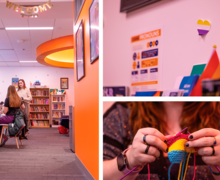Had Danielle Moon, a freshman in the College of Arts and Sciences, known Syracuse University’s acceptance rate beforehand, she said she wouldn’t have been as nervous waiting to hear from the school last spring.
‘I was kind of surprised,’ Moon said about learning she had been admitted. ‘But I was really excited.’
Of the 22,925 students who applied to Syracuse University for fall 2010, 13,694 were admitted, putting SU’s acceptance rate at 59.7 percent — higher than most other private schools. The school had a target of 3,300 students, but 3,467 enrolled.
The acceptance rate fell compared to 2009, when it was at 60.1 percent, and to 2002, when it was at 80.3 percent, according to information prepared by the Office of Enrollment Management.
This year is a change from the past two years when, due to difficult economic times, the school actively recruited and offered more financial aid in attempts to meet admission goals, said Eric Spina, vice chancellor and provost.
The school admitted fewer students and doled out a lower percentage of financial aid in 2010, but the yield of students accepting SU’s offer was unexpectedly higher, Spina said.
‘If we had known what our yield rate was going to be, we could have admitted fewer students, which would have driven the acceptance rate down,’ Spina said.
Donald Saleh, vice president of enrollment management, said the school has a ‘sophisticated formula’ for attaining the desired target of students, but it did not work as expected this year.
‘If you’re offering less money, fewer people are going to say, ‘Yes, they’re coming,” Saleh said. ‘And that model has worked pretty well over the past few years, and something happened this year that threw it off.’
Saleh said he had talked to other institutions like SU, and they experienced the same trend. Saleh said the schools were still looking into why their ‘magnetism’ had increased.
While Syracuse is at an almost 60 percent admissions rate, larger public schools like the University of Maryland, College Park accepted 45 percent of students and the University of Delaware accepted 48 percent, according to an article updated Aug. 3 on The New York Times’ website.
Admissions rates in 2010 for smaller, private institutions were also much lower, according to the article. Bucknell University accepted 31 percent, Cornell accepted 18 percent and Brown accepted 9 percent.
SU did not depend on drawing students from the waitlist to meet the incoming class goal, Saleh said. Between five and 10 students were removed from the waitlist and granted acceptance this year.
Saleh said the university is still accepting academically strong students, citing information prepared by the Office of Enrollment Management.
In fall 2002, incoming students had a median SAT score of 1180 and mean GPA of 3.49. Fall 2010 students had a median SAT score of 1170 and a mean GPA of 3.60. Incoming 2009 students had the same mean GPA and a SAT score of 1160.
Saleh predicted the acceptance rate will fall into the 50 percent range within the next few years, and he said he would like to see the university be more selective, while still drawing from a larger selection pool next year.
The target acceptance rate for next year will be decided in the next couple months, but Saleh said he anticipates admitting fewer students.
Spina said SU is happy with the new class, and the school is meeting the desired mix of students.
‘We’re accepting good students, and the students are working hard while they’re here,’ Spina said. He said the reports of SU graduates moving on to the best graduate schools and into jobs during the difficult economic times has proved the quality of the SU name.
Spina said SU is not concerned the university was being judged against other institutions because of its higher acceptance rate.
‘Selectivity is not the thing to optimize around,’ Spina said. ‘What we want to optimize around is the quality at large of the incoming class.’
Julie Walas, recruiting specialist for the School of Information Studies, said SU has come a long way from a period about 10 years ago when the acceptance rate was around 80 percent.
Still, changes have had to be made to deal with the larger size of the incoming class. The iSchool added one more freshman forum advising group — led by Walas herself — and restricted outside students from enrolling in certain courses.
Ross Friedman, a freshman marketing and management major, said the attention he receives from professors in class depends on whether he is in a large lecture or a small class.
‘I expected to be a number, and that’s what I am in a class of 300,’ Friedman said.
Friedman said he was shocked to learn he had gotten into SU and one of the top nationally ranked business programs in the country. He had worried his SAT and GPA scores were not good enough.
Now here, he said he loves the university, but said SU risked losing its good name because of the high acceptance rate.
Kandice Salomone, associate dean of advising and academic support in the College of Arts and Sciences, said the office has had to make small adjustments to deal with more students. To handle additional summer processing, Advising and Academic Support typically hires five summer workers, but seven were hired this year.
She said the traditional ‘summer melt’ of losing a few incoming students over the summer did not happen this year and caused the extra workload.
‘I was a little nervous about being able to do this,’ Salomone said. ‘But I was pleasantly surprised.’
Class size has not changed, ensuring students get the same amount of attention, Salomone said. There are still 16 students in each first-year forum group, which runs first semester to help new students adjust to the university, and 87 faculty members assigned to the groups.
Maximo Patino, director of recruitment and diversity at the S.I. Newhouse School of Public Communications, said both SU and Newhouse are still places where students could feel like more than just a number, despite the increasing number of those attending.
‘We’re not Penn State, we’re not Texas at Austin,’ Patino said. ‘These are programs that have 40,000 plus students.’
Patino said he did not think SU’s reputation was at risk, but instead was positively changing, citing the increased geographical diversity. SU has a recruiting specialist in Los Angeles and another moved into an Atlanta office last week.
Patino said Newhouse was also becoming more ethnically diverse; incoming students of diverse ethnic background was at 9.8 percent in 1999 and is at 23 percent in 2010.
Terra Peckskamp, director of the Office of Residence Life, said ORL did not have any additional concerns for the incoming class because of the size.
‘The concerns we have for this year’s class are the same as they are for any incoming class: that we are able to develop strong residential communities where students are able to connect with one another, find time and space to focus on their academics and that we are able to meet the safety and security needs of our residents,’ Peckskamp said in e-mail. ‘This year, as any year, we will be able to do that.’
The primary impact of the larger class is students are living in rooms normally used as lounge space, Peckskamp said. She said ORL staff members have needed to be more creative in identifying common spaces for students to study, socialize and gather for floor meetings and activities.
But for Moon, the freshman in Arts and Sciences, dealing with so many new faces is just yet another part of adjusting to her new college life.
‘There’s so many people,’ Moon said. ‘This is the first experience I’ve had where I get to meet this many.’
Published on September 6, 2010 at 12:00 pm
Contact Dara: dkmcbrid@syr.edu | @daramcbride


